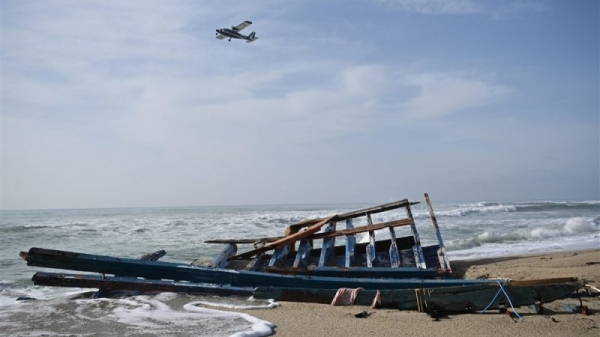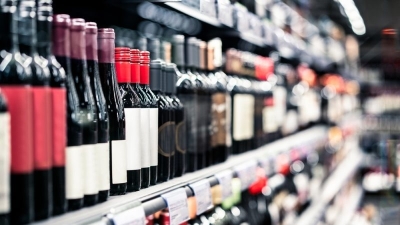Athens fumes after Italy’s accusations over deadly migrant shipwreck

A high-ranking government official in Athens has denounced as “clumsy” Italian Interior Minister Matteo Piantedosi’s statement that Greece’s “strong containment” migration policy – even with pushbacks – forced a boat with migrants to go directly to Italy, resulting in a tragedy which killed more than 60 people.
Both countries’ geographical position has put them in the spotlight of migration routes.
Migrants arriving in Italy mainly depart from the coasts of North Africa, but the number of migrants arriving from Turkey, despite being closer to Greece, has increased in the last two years. In 2022 there were about 16,000, 15% of all arrivals.
According to IOM data, 25,983 migrants have died in the Mediterranean since 2014.
“Greece is implementing policies of strong containment of arrivals on that route, even with pushbacks that are under scrutiny from the European Union,” Piantedosi said.
“So that – and survivors will be asked about it – will have probably influenced the decision to come directly to Italy,” the minister said.
The boat that wrecked last Sunday on the coast of Crotone, Calabria, had departed from Izmir, Turkey, 20km away from some Greek islands.
In Rome, sources said it was impossible for Greece not to detect the boat before it reached Italian waters. They even hinted that the Greek authorities intentionally let it pass their seas.
“In the Aegean every day we have thousands of boats and ships […] not everything can be detected by radars unless a patrol vessel identifies a suspicious behaviour”, the Greek government source told EURACTIV.
“Italy’s accusation is clumsy”, the source added.
EURACTIV was informed that at a meeting in Malta on Friday, migration ministers of the two countries would discuss the incident. The Maltese government have also been accused of ignoring vessels plea for help, responding slowly, and passing the buck to others, including the controversial Libyan Coastguard.
Italian Prime Minister Giorgia Meloni and her Greek counterpart Kyriakos Mitsotakis have so far said they are collaborating closely on migration. Meloni recently emphasised that she is sitting “at the same desk” with Mitsotakis at the EU Council.
The source explained that the Dublin regulation could explain migrants’ behaviour.
The official said migrants do not want to stay in Greece because they know that they will be stuck in organised migration camps. Instead, they prefer to go to Italy, and from there, it’s “easier” to leave for Germany or other central EU countries, the source added.
“Italy does not have the migration reception infrastructure that Greece has, and therefore migrants prefer Italy as a way to reach central Europe”, the source said.
Greece has created more than 32 migration facilities since 2015.
The active hotspots in Italy are Lampedusa, Pozzallo, Messina and Taranto.
But Lampedusa, particularly, has been facing great challenges.
Last summer, the average number of migrants received at the Lampedusa hotspot was 1,600 against a capacity of 350 beds. In 2022, overall, there were over 100,000 transits, and the hotspot is constantly collapsing. Right now, admissions are close to 1,300.
“We have an average of 300-400 arrivals a day (…), and we manage to transfer about 200”, Lampedusa Mayor Filippo Mannino told AdnKronos.
Only lousy weather temporarily stops the landings. “These are the only times when there is some calm when law enforcement and personnel involved in managing the landings can breathe a sigh of relief”, explained Mannino, who harshly criticised “Europe’s silence”.
According to Aegean Boat Report data, in 2023, Greece turned back 73 boats and about 1,800 migrants. Asylum claims in 2022 were 279 per 100,000 population, compared to 133 in Italy.
Who is responsible for the shipwreck in Calabria?
Six months ago, the European Court of Human Rights condemned Greece for rejecting a boat that later sank, causing the death of eleven migrants.
Italy could face the same because of the shipwreck in Calabria, given the ongoing heated debate over the discharge of responsibility about the rescue of the boat.
The Italian Coast Guard and Guardia di Finanza, which carried out the operations at sea, are under investigation. Frontex says it reported the boat’s presence near the Italian coast as early as Saturday (25 February) the evening before it ran aground around 4 am. on Sunday.
Rescue operations were not initiated during this time, as Italian authorities claimed no distress signal came from Frontex.
By the time rescuers were able to get to the scene, hampered by rough seas, it was too late for many of the migrants.
Rescuers said most of the migrants were from Afghanistan, while others were from Pakistan, Iran, Somalia, and Syria.
Interior Minister Matteo Piantedosi’s words on the tragedy, in which more than 60 people lost their lives, and many are missing, ignited the immigration debate in Italy with the newly appointed Democratic Party (S&D) Secretary Elly Schlein calling for his resignation.
Tough migration policy
Minister Matteo Piantedosi is officially a technical minister in the Meloni government, and he is certainly the one closest to Deputy Prime Minister and Transport Minister Matteo Salvini.
In 2018, Piantedosi was the Interior Ministry’s chief of staff when Salvini was a minister in the first government led by Giuseppe Conte. After the fall of the so-called Conte I, in the summer of 2019, Piantedosi became prefect of Rome, and Giorgia Meloni chose last October to lead the Interior ministry.
Accustomed to the Italian right-wing’s repressive policy toward migration, Piantedosi immediately took charge with interventions against the phenomenon that has affected the country for years, given its geographical proximity to the North African coast.
The “code of conduct” for NGO ships operating in the Mediterranean was recently approved by the Italian parliament but was widely criticised by the opposition and several humanitarian groups because it would greatly complicate rescue operations.
As they point out from the opposition to the Meloni government, many of the landings in Italy take place without the necessary intermediation of NGO ships, which, however, have been defined by Frontex as a ‘pull factor,’ meaning that it increases the departures because boatmen transporting the migrants know they will encounter a rescue vessel halfway to Italy.
“The number of migrants rescued by NGOs is insignificant compared to total arrivals. Italy continues to be a transit country […] There are 500/600 thousand irregular migrants in Italy”, Carlo Calenda, leader of Azione, the party that is soon expected to officially merge with former PM Matteo Renzi’s Italia Viva (Renew), wrote on Twitter.
(Sarantis Michalopoulos | EURACTIV.com – Federica Pascale | EURACTIV Italy)



